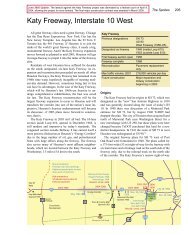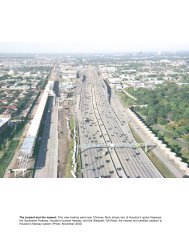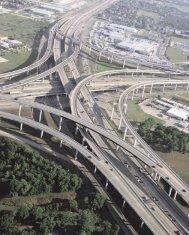Downtown Freeways 127<strong>The</strong> Houston skyline, September 2002: <strong>The</strong> downtown Houston building boom came to an end in 1986 with the collapseof Houston’s energy economy. Since 1987, all newly constructed office towers have been no more than 40 floorstall. <strong>The</strong> popularity of suburban, campus-style office space seems to suggest that Houston’s skyline will not receive anymajor new high-rise additions for the indefinite future. Still, downtown Houston remained vibrant in the 1990s and 2000swith the construction of new housing, sports stadiums, and the rebuilding of basic infrastructure.United States and the 23rd tallest skyscraper in the world.In 1983 the 71-floor, 970-foot-tall (296 m) Wells FargoPlaza was completed. Skyscraper construction in downtownHouston came to an end in the mid-1980s with thecollapse of Houston’s energy industry and the resultingsevere economic recession. When the 53-floor TexacoHeritage Plaza was completed in 1987, it appeared thatno more skyscrapers would be constructed for a long,long time. In 2000, however, the Houston-based EnronCorporation began construction of a 40-floor skyscraperwhich was nearing completion in late 2001, just as thecompany collapsed in one of the most dramatic corporatefailures in the history of the United States. Other smalleroffice structures were built in the 2000-2003 period. InDecember 2001, downtown Houston had approximately40 million square feet of office space, including 28 millionsquare feet of class A office space. 11In spite of the impressive skyline and freeway network,urban advocates in the 1980s complained that downtownHouston was hollow, becoming nearly deserted at the endof the business day. Houston’s underground tunnel systemkept office workers below ground, inhibiting street activity.Downtown Houston would achieve revitalization inthe 1990s, a renaissance engineered by Mayor Bob Lanier,Houston’s great road building advocate of the post-1980era. After concentrating his efforts on transportation in the1980s, Lanier was elected mayor in 1991 and focused onmaking the city safe and rebuilding basic infrastructure,including roads and sidewalks. When Lanier exited themayor’s office at the end of 1997 due to term limits, therevitalization of downtown was in full progress. Numerousapartment and loft-style residential structures werebuilt, bringing long-sought urban dwellers into the coreof downtown. Lanier’s successor, Lee Brown, sought tocapitalize on the downtown momentum by constructing alight rail line on Main Street. Construction on the rail linebegan in 2001 and is scheduled for opening in 2004.<strong>The</strong> Second WaveIn the United States, construction and improvement ofdowntown freeways was largely dormant by the 1970s.Freeways in downtown districts had fallen into disfavorwith planners who became more interested in promotingtransit and pedestrian activity. Some viewed freeways as
128 Houston FreewaysHouston’s freeways turn into lakes: Tropical Storm Allison in <strong>June</strong> 2001 unleashed a major flood event, and Houston’s freewayssustained some of the most dramatic flooding. Virtually all depressed freeways around Houston filled with water. Flooding alongWhite Oak Bayou submerged much of the at-grade interchange of <strong>IH</strong> 45 and <strong>IH</strong> <strong>10</strong> north of downtown, shown above in a phototaken <strong>June</strong> 9, 2001. (Photo: Houston Chronicle)barriers, cutting off parts of the city from each other. LosAngeles, always the bellwether, typified this trend. Muchof its downtown interchange complex dates from the early1950s and was complete by 1962. It has seen practicallyno improvement since its original completion, and no majorimprovement is planned in the future. <strong>The</strong> Los Angelesdowntown freeway complex is certainly showing its age.Phoenix, Arizona, in a project completed in 1990, placeda downtown section of <strong>IH</strong> <strong>10</strong> in a tunnel to minimizeimpacts. Boston, Massachusetts, spent a staggering $15billion to rid its downtown of freeways by burying themunderground.But Houston would retain and improve its downtownfreeway system starting in the mid-1990s. <strong>The</strong> PierceElevated, <strong>IH</strong> 45 on the south side of downtown, was reconstructedin 1997. <strong>US</strong> <strong>59</strong> on the east side of downtownwas resurfaced and widened to eight continuous lanes in1997. In October 2000, a long, elevated connector rampfor buses and high occupancy vehicles was completedover the <strong>IH</strong> <strong>10</strong>-<strong>IH</strong> 45 interchange on the northwest sideof downtown.In 1998, the first major construction since the completionof the downtown interchange complex in 1980 wasunderway. A major new interchange took shape on thenortheast side of downtown at the intersection of EastexFreeway (<strong>US</strong> <strong>59</strong>) and the East Freeway (<strong>IH</strong> <strong>10</strong>). Includedin the interchange is the downtown distribution systemoriginally envisioned by planners in the 1950s. <strong>The</strong> operationalefficiency of the distribution system may becompromised when it opens in 2004 because a new baseballstadium was constructed on the location of the formerUnion Station rail yard. <strong>The</strong> stadium ensures a permanentbarrier to north-south traffic flow where the connectionramps reach downtown streets. <strong>The</strong> new interchange willalso accommodate a planned new radial spoke for thedowntown freeway system, the extension of the HardyToll Road into downtown Houston as a toll-free facility.Construction of the Hardy Toll Road extension is expectedto begin in <strong>2005</strong>, with completion around 2007.In 2003 a comprehensive study is in progress to determinefuture improvements to <strong>IH</strong> 45 and the section of <strong>US</strong><strong>59</strong> south of <strong>IH</strong> 45. <strong>The</strong> six-lane Pierce Elevated section of<strong>IH</strong> 45 has become a critical bottleneck in Houston’s freewaysystem. <strong>The</strong> study will identify needed improvementsand determine what is feasible for the Pierce Elevated,which has high-rise structures immediately adjacent toit. At the very minimum, the oldest sections of Houston’sdowntown interchange complex should be brought up tomodern standards, and recommendations could includemajor expansions or additions.








